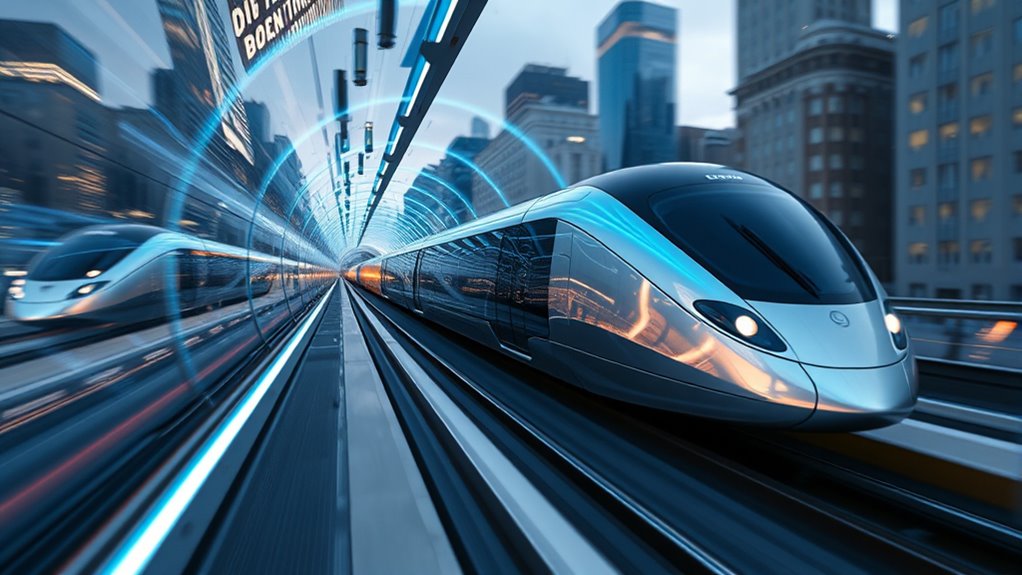When considering ultra-fast transit, understanding how hyperloops and maglevs use physics can change how you see the future of travel. Both systems rely on electromagnetic principles, but they operate in very different ways to achieve high speeds. As you explore their mechanics, you’ll discover why these technologies could revolutionize how we move across long distances. The key differences might surprise you, and the reasons behind their design choices could make you rethink transportation entirely.
Key Takeaways
- Hyperloops use vacuum tubes to eliminate air resistance, enabling speeds over 700 mph, unlike maglevs which rely on magnetic levitation within traditional tracks.
- Hyperloops create near-vacuum environments to drastically reduce drag, while maglev trains lift above guideways using electromagnetic forces to eliminate wheel-rail friction.
- Both systems harness advanced physics: hyperloops minimize air resistance for high speeds, maglevs utilize magnetic fields for precise levitation and propulsion.
- Hyperloop infrastructure involves extensive vacuum tube engineering with high costs, whereas maglevs operate on existing or new tracks with proven feasibility.
- The physics principles of both—airless travel and magnetic levitation—are key to achieving ultra-fast, efficient transit solutions.

Hyperloops and maglevs represent two cutting-edge transportation technologies promising faster and more efficient travel. At the core of these innovations are principles rooted in advanced physics, aiming to drastically cut travel times and reduce energy consumption. The hyperloop concept relies heavily on vacuum tubes to eliminate air resistance, allowing pods to glide at incredible speeds with minimal drag. These sealed tubes create a near-vacuum environment, markedly reducing the air molecules that slow down traditional high-speed trains. By removing air resistance, hyperloops can reach speeds that surpass current rail or air travel, moving passengers at over 700 miles per hour. This setup means less energy is needed to maintain high velocities, making hyperloops potentially more sustainable than conventional transportation methods.
Hyperloops use vacuum tubes to achieve speeds over 700 mph, reducing energy and revolutionizing transportation.
Magnetic levitation, or maglev, is the key technology powering many high-speed trains today. Instead of wheels rolling along tracks, maglev trains use powerful electromagnets to lift the train above the guideway, eliminating friction between wheels and rails. This magnetic levitation allows for smoother, quieter rides and enables trains to accelerate and decelerate rapidly while maintaining high speeds. Unlike hyperloops, maglevs operate within traditional tunnel or track environments, though some designs aim to incorporate vacuum-like conditions for even greater efficiency. The principle of magnetic levitation is simple yet powerful: by controlling the magnetic fields, you can precisely manipulate the train’s position and speed, drastically reducing mechanical wear and tear and making maintenance easier. Additionally, ongoing research into energy-efficient propulsion methods could further enhance maglev systems’ sustainability and performance.
While hyperloops aim to harness vacuum tubes for ultra-fast point-to-point travel, maglevs focus on improving existing rail systems with magnetic levitation technology. The hyperloop’s reliance on vacuum tubes means that the infrastructure costs are substantial, requiring extensive engineering to maintain the low-pressure environment. Yet, this setup offers the potential for unprecedented speeds over long distances. On the other hand, maglev trains are already operational in some countries, demonstrating how magnetic levitation can revolutionize rail travel by providing high-speed, reliable, and energy-efficient transportation within more familiar routes.
Both systems showcase the innovative use of physics to redefine how we move. The hyperloop’s vacuum environment minimizes air resistance, while magnetic levitation eliminates friction altogether. These principles are not just theoretical; they are the foundation of feasible, real-world transportation solutions that could reshape the future of travel. Whether you’re looking at the hyperloop’s potential for intercity transit or maglev’s ongoing high-speed rail experiments, both technologies are pushing the boundaries of speed and efficiency, promising a future where travel is faster, smoother, and more sustainable.
Conclusion
As you consider these ultra-fast transit options, it’s fascinating how both hyperloops and maglevs harness advanced physics to revolutionize travel. Coincidentally, their reliance on electromagnetic principles shows just how innovative science can be—whether reducing air resistance in vacuum tubes or eliminating friction with magnetic levitation. Ultimately, both systems are shaping the future of transportation, proving that sometimes, science and imagination collide to make our fastest journeys possible.









